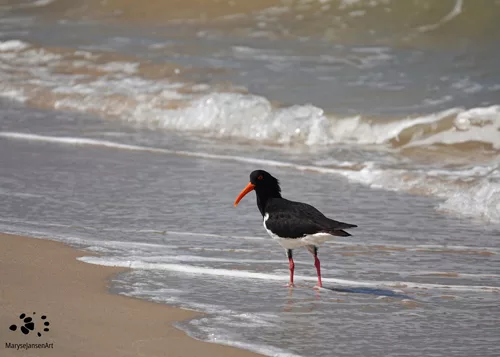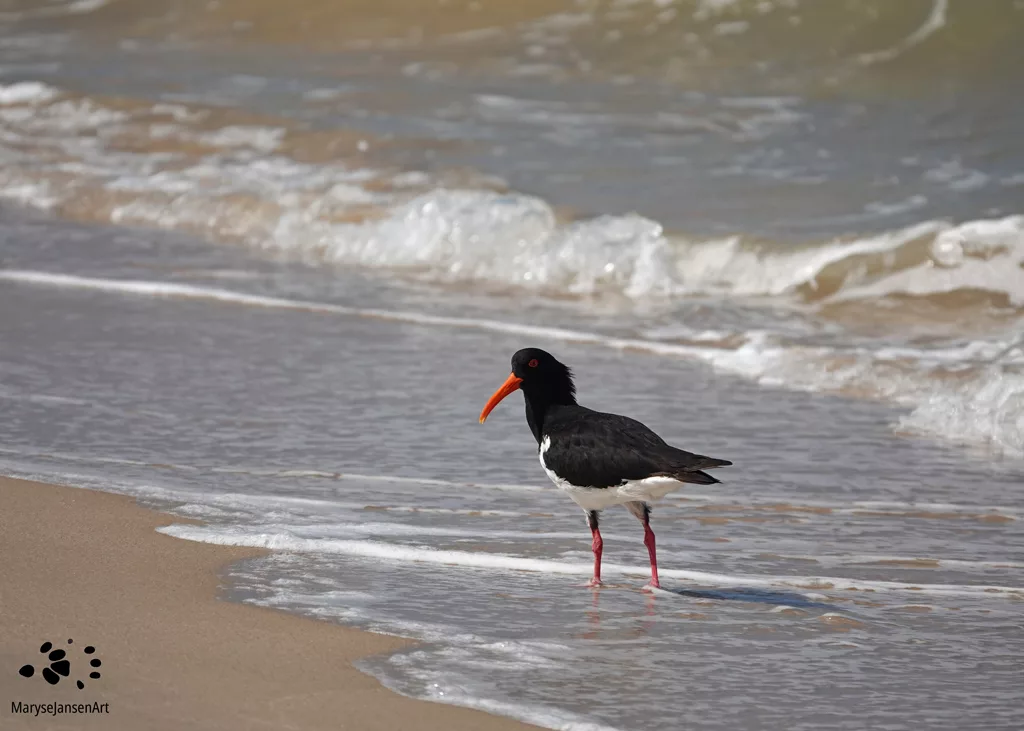Bird Photography with marysejansenart
Shy Beach Combers in Search of Mulloscs

Table of Contents
Exploring a secluded tropical beach
I emerge from the vegetation onto the beach and immediately I spot a pair of Pied Oystercatchers flying past. These shorebirds are easy to recognize. They are quite large, about 50cm tall. They are mainly black, with a white belly, extending a little bit towards the shoulders. What stands out about them is the colour of their long, bright orange-red bill, eye-ring and eyes; as well as the coral-pink coloured legs. This bird can be found in coastal areas all around Australia. Closely related forms exist all over the world.
There are not many people in this tropical paradise. The few that are here seem to be more interested in swimming or reading a book and they keep to my right, so I take a left turn! I love exploring quiet beaches and this is one of them. It’s quite narrow and backed by vegetation dominated by Beach Almond Trees, She-oaks and Palm Trees. The sand is littered with driftwood.
The Beach Almonds have attracted a flock of Red-tailed Black Cockatoos! I move very, very slowly and it is amazing how close these normally very shy birds allow me while they are feasting on these fruits! I don’t go so close as to chase them away, it is important to always respect wildlife’s personal space! When you take your time and observe them closely, you can see when they become uneasy with your presence and it’s time to back off. I don’t let it come to that and I enjoy from a place where they clearly feel safe.
Pied Oystercatchers love mulloscs
I move on and there are those Pied Oystercatchers again, they are combing the beach now, in search of food. They don’t live up to their name, as they seldom eat oysters. They feed mainly on bivalve mulloscs. Their long, thin bill is the perfect tool to prise open the shells. Worms, crustaceans and insects are also on the menu.
Today, they get a good fill of their favourite meal! The birds use their sight to find their food but they also periodically prod their bill in the wet sand hoping for a catch. I watch them for a little while in their search. Every now and then they get knocked off their balance a bit by a strong, incoming wave but that doesn’t deter them.
Like those cockatoos, these birds are normally very shy of people, so again I feel privileged that I am able to observe them from a relatively close distance for a little while. They keep moving though in their search of food and go further and further away from where I am. I let them go.
Territorial but easily frightened
It is most common to see these birds in pairs, like today. Occasionally you might see a small flock. They prefer sandy beaches, mudflats and sandbanks over rocky coastlines. Pied Oystercatchers establish a territory of about 200m of beach where they breed in pairs. The nest is a shallow dent, created in the sand, shell grit or shingle. It is located just above the high tide line. Only 5 species of Australian shorebirds nest exclusively on the beach and the Pied Oystercatcher is one of them!
Both birds defend their territory. The otherwise quiet birds have a piercing alarm-call, which sounds like ‘pit-a-peep’. They lay a clutch of 2-3 eggs, which are well camouflaged on the sand with a pale brown appearance, blotched and streaked with darker shades. Both the male and the female bird share the parenting duties: incubating the eggs and caring for the young.
Parents protect the eggs and the young chicks by displaying distracting behaviour. They will draw attention of intruders and predators by making noises away from the nest. It has even been observed that they lure predators away from the nest by pretending to be injured and vulnerable themselves!
Be aware of Pied Oystercatchers calling out and taking flight when you approach them. It means you have come too close. When frightened, they leave their eggs or chicks unattended, which leaves them very vulnerable. You can imagine it is very important to respect the space of breeding Pied Oystercatchers! Known breeding sites will have signs up to alert you.
In nature you can always expect the unexpected
It is time for me to leave the beach. I did not come to this beach to film an episode of ‘Come for a walk in the Australian Bush’. I simply intended to spend a little bit of time to relax and enjoy the scenery. But nature always has a way to provide you with the unexpected! I enjoyed these special encounters with the birds so much, that I couldn’t help myself and wanted to share them with you! So here is a bonus episode:
If you are interested in purchasing ‘Pied Oystercatcher’ or would like to see what the image looks like on the various products, please head to my shop.


